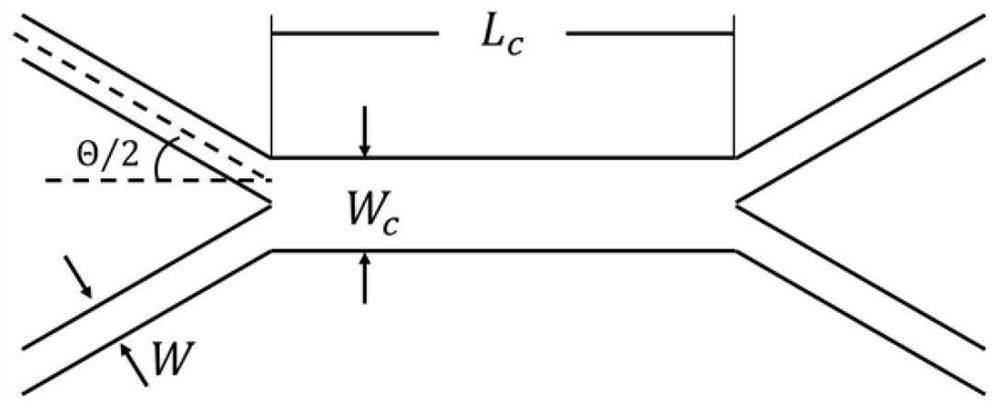An electronically controlled polarization entangled state generation chip based on periodically poled lithium niobate waveguide
A periodic polarization, lithium niobate technology, applied in the fields of quantum information technology, optoelectronic technology and nonlinear optics, can solve problems such as large, unstable and complex optical paths
- Summary
- Abstract
- Description
- Claims
- Application Information
AI Technical Summary
Problems solved by technology
Method used
Image
Examples
Embodiment 1
[0059] Polarization-entangled chip setup at 1550nm.
[0060] The pump light is 780nm, and the degenerate photon pair is 1560nm. When the length of the electrodes 8, 9, and 10 is set to 4.7 mm, the voltage of 11.0 volts can cause the relative phase of the two pump lasers to change by 2π.
[0061] The design of the periodically polarized region 15 is as follows. Design its period to satisfy the quasi-phase-matching condition β for spontaneous parametric downconversion in the waveguide p -β s -β i =2π / Λ, where β p ,β s ,β i are the fundamental mode propagation constants of the pump, signal and idler light respectively, which are jointly determined by the dispersion of the lithium niobate material and the waveguide processing technology. For the titanium diffusion waveguide, both horizontally polarized light and vertically polarized light can propagate, using the nonlinear coefficient d 31 . According to our process conditions, changing the polarization period will corres...
Embodiment 2
[0067] Example 2: Polarization-entangled chip setup around 800nm.
[0068] The polarization entanglement chip setup near 800nm is very similar to that of 1550nm. Pumping with pump light near 400nm, the waveguide on the chip is changed to a single-mode waveguide of 400nm and 800nm, and the polarization period of the polarized area is correspondingly changed to The polarization period of the 400nm to 800nm process is specified, and the other functional units are designed according to 800nm, but the polarization beam splitting needs to be designed separately, and the small-angle cross polarization beam splitting design is adopted. The simulation design results are given below. The design found that the width W of the incident waveguide is 7.5 microns, the included angle Θ is 1.49 degrees, and the width W of the waveguide in the coupling region c 15 µm, length L c to 6000 microns. Use Rsoft software to simulate such as Figure 12 , and the left and right pictures are the b...
Embodiment 3
[0069] Embodiment 3: Polarization entanglement chip for polarization beam splitting realized by composite process of proton exchange waveguide and titanium diffusion waveguide.
[0070] figure 1 In Region III, there are various on-chip ways to realize the polarization beam splitting function. For example, using the proton exchange waveguide and titanium diffusion waveguide composite technology to design a non-fully symmetrical three-waveguide coupling structure, such as Figure 13 . Waveguides 1 and 3 are titanium diffused lithium niobate waveguides, and waveguide 2 is a proton exchange waveguide. Waveguides 1 and 3 support horizontally and vertically polarized light, and waveguide 2 only supports vertically polarized light. Using this characteristic, a certain coupling length is set, the vertically polarized light is coupled to the cross output of the waveguide 3(1), and the horizontally polarized light is not coupled, thereby realizing polarization beam splitting. Wavegu...
PUM
| Property | Measurement | Unit |
|---|---|---|
| length | aaaaa | aaaaa |
| conversion efficiency | aaaaa | aaaaa |
| refractive index | aaaaa | aaaaa |
Abstract
Description
Claims
Application Information
 Login to View More
Login to View More - R&D
- Intellectual Property
- Life Sciences
- Materials
- Tech Scout
- Unparalleled Data Quality
- Higher Quality Content
- 60% Fewer Hallucinations
Browse by: Latest US Patents, China's latest patents, Technical Efficacy Thesaurus, Application Domain, Technology Topic, Popular Technical Reports.
© 2025 PatSnap. All rights reserved.Legal|Privacy policy|Modern Slavery Act Transparency Statement|Sitemap|About US| Contact US: help@patsnap.com



